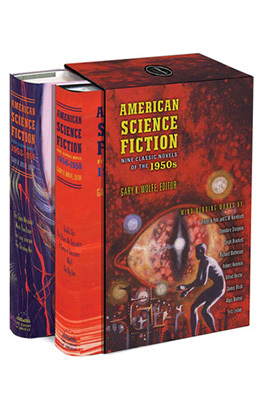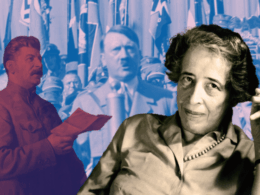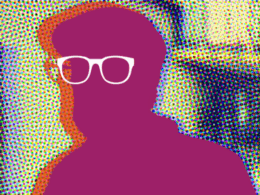Gary K. Wolfe, author of Evaporating Genres: Essays on Fantastic Literature, spoke with us about the recent publication of the two-volume boxed set American Science Fiction: Nine Classic Novels of the 1950s, which he edited for Library of America.
Library of America: When and how did you first discover the writers and books collected in this set?
Gary K. Wolfe: I’m reasonably certain I first read all these novels before I was fifteen, since I was of the generation that more or less came of age with 1950s science fiction. Something that seems to be a common experience among young science fiction readers, probably true even today, is that we quickly develop a sense not only of our favorite writers, but even our favorite publishers, anthologists, and cover artists. By the time I’d been reading science fiction for a couple of years, I knew that my tastes veered toward Ballantine Books, and those wonderful Richard Powers covers (one appears on the Library of America boxed set and another on the jacket of the 1953–56 volume).
I returned to these authors later when the study of science fiction became part of my academic work, and then again when I was rereading to make the selection for this two-volume set. Obviously, some writers and titles stood up better than others, but I was a bit pleasantly surprised at how well some of them not only stood up, but gained added resonance in perspective.
LOA: What makes the 1950s the golden age of the science fiction novel?
Wolfe: “Golden age” is probably a term that takes on different meanings depending on which generation of science fiction readers you talk to. A fan named Peter Graham is said to have originated the widely-quoted claim that “the golden age of science fiction is twelve,” and there’s probably something to that.
The most common usage, however, came about in the 1950s and pretty clearly reflected the attitudes of readers and writers of that generation. For them, the “golden age” commonly referred to the 1940s, the decade or so after John W. Campbell Jr. assumed the editorship of Astounding Science Fiction, when major writers such as Isaac Asimov, Robert Heinlein, Theodore Sturgeon, Ray Bradbury, and others developed their reputations.
The 1940s was a crucial time for science fiction’s development, but it wasn’t a golden age of novels. That wasn’t possible until there was a substantial market for them, which didn’t develop until the late 1940s and early 1950s, when major publishers began to take note of the genre, possibly spurred on by the rise of paperback books and the demand for new material. It suddenly became possible for writers—whose previous markets had mostly consisted of pulp short fiction magazines—to conceive a full-length novel and expect to find a publisher for it, and possibly even a decent advance. This was more true in the U.S. than in England, it should be noted, which had a slightly different literary history for science fiction.
LOA: Did you have any principles or guidelines in mind in making the selection of the novels?
Wolfe: We began with some obvious ground rules, such as defining the 50s as the years 1950–59. My own rule was that the novels we selected should be genuine 1950s novels, meaning that they were conceived as novels and not novel-length works assembled from earlier short stories. A number of important SF works published during the 1950s—Ray Bradbury’s The Martian Chronicles, Isaac Asimov’s I, Robot, Clifford Simak’s City, James Blish’s The Seedling Stars—were actually story collections with some connective material added, or what are sometimes called “fix-ups.” My feeling was that such works actually represented the short fiction of the 1940s rather than the novels of the 1950s.
Beyond that, we tried to avoid a too-obvious “greatest hits” collection. Instead, we wanted a variety of SF themes and a variety of ways in which these works informed, or were informed by, the ongoing dialogue about science, technology, and society that was quite lively during that decade. It would be possible to fill a volume with nothing but nuclear apocalypse tales, for example, but that could lead to a distorted view of the field, and would ignore the ways in which science fiction grappled with other issues, from religion (A Case of Conscience) to consumerism (The Space Merchants).
LOA: How would you recommend these novels to readers who aren’t knowledgeable about SF or regular readers of it?
Wolfe: I often hear complaints from non-readers that some modern science fiction can be challenging, or that it’s difficult to find an accessible entry point for reading it. It’s true that SF has developed a sizable number of conventions and tropes that can be confusing to the uninitiated; sometimes even the way SF uses language can be daunting. These novels were written when SF was still in the process of developing those conventions and usages, and thus can provide both a solid grounding and a convenient entry point. I also hear from a number of people who read science fiction when younger, but moved on as they grew older. For them there may be a nostalgia factor—although that really isn’t the point of the collection—and it may provide an opportunity to re-examine some of those youthful passions in perspective.
LOA: How would you recommend the set to avid SF buffs?
Wolfe: Science fiction is old enough by now to have several generations of fans, and in each generation are those who want to “read back” into the history of the field before they began reading it. I’ve met a number of readers, already in their 40s, whose first experiences with the genre date from the cyberpunk period, or William Gibson’s Neuromancer, for example. They might be interested in discovering how Gibson echoes some of Alfred Bester, or what popular contemporary writers like Connie Willis or Neil Gaiman learned from Robert Heinlein or Fritz Leiber. This is one of the reasons I think the website accompanying the set is so important; the essays by contemporary writers offer an opening into the archaeology of the genre, as well of evidence of its continuing influence. In addition, I believe the novels themselves stand out as good SF even by today’s standards.
LOA: Do you have a favorite novel in the collection?
Wolfe: I suppose like most readers, my favorites change over time. The novels which most affected me when younger were probably Sturgeon’s More Than Human and Brackett’s The Long Tomorrow, in that order. I think they hold up pretty well, as does the satire of Pohl and Kornbluth’s The Space Merchants. But the first novel I selected for the collection was Bester’s The Stars My Destination, which is capable of thoroughly surprising readers even today.
The online companion includes appreciations of the novels by contemporary SF novelists—Neil Gaiman, William Gibson, Peter Straub, Connie Willis, and others. How has contemporary writing been influenced by the novels from the 1950s? What’s the relationship between the classic works collected here and the contemporary literary scene?
I think those contemporary writers speak better for themselves than I could hope to, and I’ve already mentioned how some of the tropes and conventions of the field were very much still in development during the 50s. What has surprised and delighted me over the last several years is the degree to which the work of contemporary writers not directly associated with science fiction—Michael Chabon, Jonathan Lethem, Junot Díaz, Margaret Atwood, etc.—has been informed by works like these. We’re beginning to see a broadening of literary ancestry, if you will, expanding beyond the traditional canon to include not only science fiction, but the crime and noir novels which The Library of America has also recognized in earlier collections.
It’s a little harder to gauge the impact of the ideas in these novels in the wider popular culture, but it’s interesting to note how the pastoral post-apocalyptic settings of novels and films like The Hunger Games or new TV series like Revolution echo the setting of Brackett’s The Long Tomorrow, or how satires of the advertising field like Mad Men echo elements of Pohl and Kornbluth’s The Space Merchants.
LOA: What’s the most fun/interesting discovery you made while working on the online companion?
Wolfe: It was surprising to discover how much audio and video material was available, including several radio and TV adaptations of works by our authors (not necessarily the novels themselves) which are on the website. These give a sense of how science fiction appeared in other media during the 50s, of what its pop-culture surfaces looked like in an era before the advent of big-budget CGI epics. For me the most delightful discovery was the wide-ranging audio interview with Leigh Brackett, which is full of fascinating bits about her Hollywood career as well as her SF and mystery writing.
LOA: The novels collected in the set are over half a century old. In what ways are the issues/themes/fears they are grappling with still our own?
Wolfe: Well, nuclear anxiety certainly hasn’t gone away, as the current concerns over Iran indicate. But it’s changed focus; instead of fears of a global nuclear apocalypse waged by superpowers, it’s shifted toward terrorism and rogue regimes. The power of intrusive advertising and media is still a topic of much public discussion, although it too has shifted, from TV and newspapers toward social media and the Internet—something SF more or less missed the ball on (although SF has never been all that successful in actual predictions, which was never what it was about in the first place).
But the most effective science fiction, like the most effective fiction, is about more than topicality, and science fiction can also provide powerful literalized metaphors for more universal concerns such as identity, alienation, even revenge. Budrys’s Who? may be very much a Cold War novel in terms of its topicality, but its central issue asks what our identity is comprised of—how we would prove who we actually are if challenged. Sturgeon’s More Than Human, like much of his fiction, is about how damaged or alienated outsiders can become part of a larger whole. Even Matheson’s The Shrinking Man, perhaps the most fable-like tale in the set, deals quite literally with diminishment and loss, and (spoiler alert, perhaps) offers no scientific or technological “fix” for its protagonist’s existential condition.
LOA: Where should The Library of America go from here? What’s the next logical project?
Wolfe: The 1950s was a crucial and transformative decade in SF, but it would be overreaching to claim that it represents the entirety of the ways in which SF has contributed to American literature. I can see three possible future directions. One involves recognizing the ways in which short fiction was crucial to the development of the genre prior to the 1950s, especially in the 1930s and 1940s (or even earlier), when many of the standard templates and tropes of the genre were developed. Another would be to look at later decades, such as the 1960s and 1970s, when significant new voices—Samuel R. Delany, Ursula K. Le Guin, Joanna Russ, Roger Zelazny, Robert Silverberg, Harlan Ellison, etc.—radically changed the literary tone and ambitions of the genre. A third, obviously, would be to recognize individual writers in the manner in which The Library of America has already recognized Kurt Vonnegut and Philip K. Dick. Two writers who have passed away within the last couple of years and who would be strong candidates are Ray Bradbury and Joanna Russ.
Visit the American Science Fiction companion website for more on 1950s science fiction and these works and writers, including jacket art and photographs, additional stories, author interviews, and new appreciations by Michael Dirda, Neil Gaiman, William Gibson, Nicola Griffith, James Morrow, Tim Powers, Kit Reed, Peter Straub, and Connie Willis.




